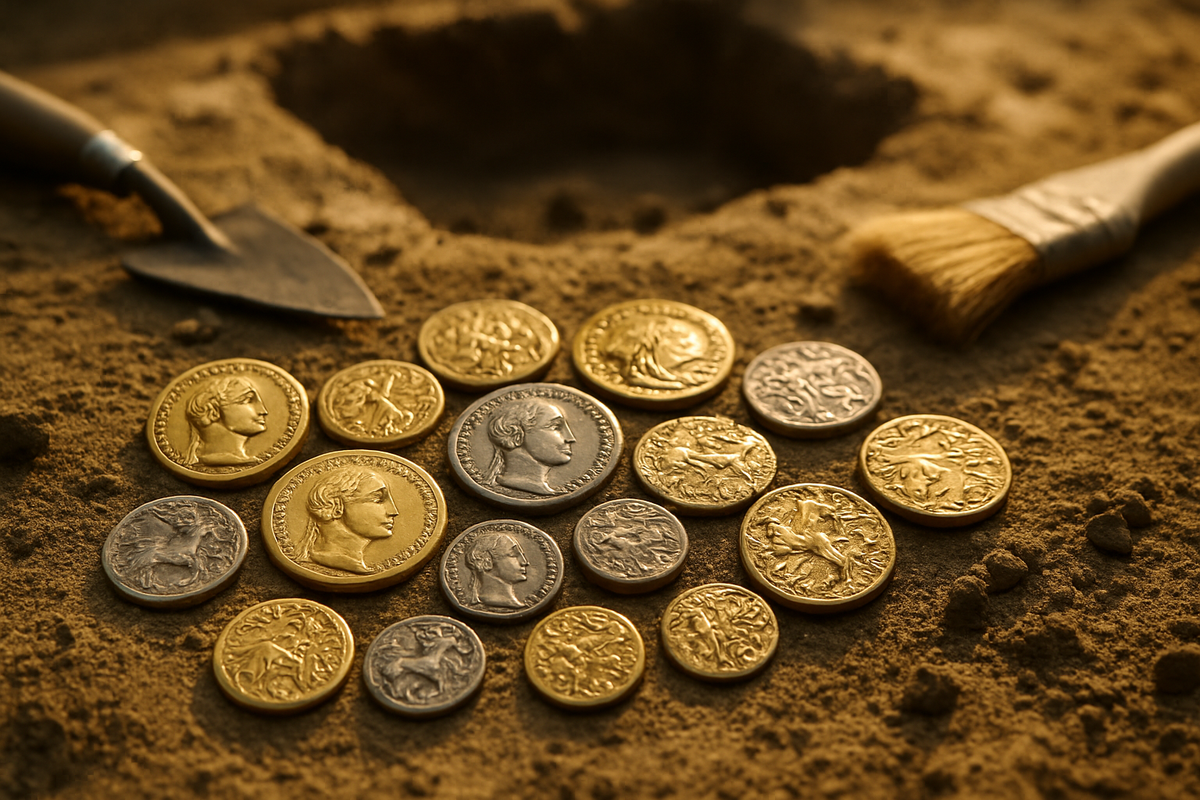
Bunnik, Netherlands – October 22, 2025 – A monumental archaeological discovery, made in October 2023, continues to reverberate through the historical and academic worlds. Two years ago, in a field near Bunnik in the Netherlands, a hoard of 404 gold and silver coins, dating back 2,000 years to the early Roman Empire, was unearthed. This "Bunnik hoard" represents an unparalleled find on mainland Europe, offering a vivid and tangible connection to Emperor Claudius's invasion of Britain in 43 CE.
The sheer volume and unique composition of the hoard—a mix of Roman and British coinage—make it a historical treasure trove. It provides direct evidence of the spoils of war and military pay handled by a high-ranking Roman officer, painting a detailed picture of the tumultuous period when Rome extended its vast empire across the English Channel. The discovery not only enriches our understanding of Roman military logistics and economic practices but also highlights the significant role the Lower German Limes played in imperial expansion.
Unearthing a 2,000-Year-Old Time Capsule
The discovery was made by two diligent metal detectorists, Reinier Koelink and Gert-Jan Messelaar, in October 2023. Their careful work in a field within the municipality of Bunnik, Utrecht, led to the revelation of a buried cache of coins less than 30 cm deep, likely originally contained within a perishable pouch. The location, while along the Neder-Germaanse Limes, was notably distant from known Roman fortifications, adding to the intrigue of its deposition.
The hoard comprises an astonishing array of ancient currency: 44 British gold staters, primarily bearing the name of King Cunobelinus (who ruled from approximately 5 to 40 CE), 72 Roman gold aurei, and 288 Roman silver denarii, alongside a singular Numidian denarius. The Roman coins span from the reign of Emperor Augustus to Emperor Claudius, with the youngest examples, including two pristine, uncirculated aurei, minted in 46-47 CE. This precise dating suggests the hoard was buried in or shortly after 47 CE, placing its concealment squarely within the initial phase of the Roman conquest of Britain.
Archaeologists from Utrecht University, collaborating with provincial authorities, quickly took charge of the site, meticulously excavating and documenting the find. Initial reactions from the academic community were of profound excitement, recognizing the hoard's unique composition as the first of its kind found on mainland Europe. The pristine condition of some coins, particularly the die-matched aurei, provides invaluable numismatic data, indicating they were part of a fresh disbursement of military wages, likely to a high-ranking officer given the hoard's substantial value—estimated to be equivalent to about 11 years of a Roman soldier's pay.
Cultural and Academic Enrichment: The True Beneficiaries
While the discovery of the Bunnik hoard does not directly impact public companies or financial markets, its significance for academic institutions, museums, and the broader field of historical research is immeasurable. Institutions such as Utrecht University, which has been instrumental in the excavation and initial analysis, will gain an unprecedented wealth of research material. This will fuel new studies into Roman military economics, the interaction between Roman and British cultures, and the specific dynamics of the conquest of Britain.
Dutch heritage organizations and museums, including potentially the Rijksmuseum van Oudheden (National Museum of Antiquities) in Leiden or local museums in Utrecht, stand to benefit immensely. The hoard offers a compelling narrative for public exhibitions, drawing visitors and fostering a deeper appreciation for ancient history. It presents a unique opportunity for educational outreach, allowing the public to connect directly with a pivotal moment in European history. The long-term cultural and educational dividends from such a discovery far outweigh any immediate financial gains, boosting academic collaboration, potential for documentaries, and the development of new educational resources.
A Wider Lens on Roman Imperialism and Frontier Life
The Bunnik hoard fits seamlessly into broader trends of understanding the Roman Empire's frontiers, particularly the Lower German Limes, which was not merely a defensive line but also a crucial artery for trade, communication, and military deployment. This discovery reinforces the Limes' role as a staging ground for the British invasion and a return route for troops bringing back both their pay and the spoils of conquest.
What makes the Bunnik hoard truly unique is its mixed composition on mainland Europe. Only one comparable find exists: the Helmingham Hall Hoard in Suffolk, England, discovered in 2019, which also contained a similar blend of British gold staters of Cunobelin and Roman gold and silver coins from the same period. This striking parallel strongly supports the interpretation that both hoards are directly linked to the Roman conquest, perhaps representing the personal wealth of officers on either side of the Channel. The Bunnik find thus provides a crucial counterpoint and comparative study opportunity for the Helmingham Hall Hoard, offering a more complete picture of the movement of wealth during the invasion. Furthermore, this discovery underscores the importance of robust regulatory and policy frameworks for heritage protection and responsible metal detecting, ensuring that such invaluable cultural assets are properly documented, preserved, and studied for the benefit of all.
Charting the Course Ahead: Research, Preservation, and Public Engagement
The immediate future for the Bunnik hoard involves intensive conservation efforts. The coins, after two millennia underground, require careful cleaning, stabilization, and detailed cataloging to prevent further degradation and to prepare them for comprehensive study. This painstaking process will be followed by in-depth academic research, including numismatic analysis, metallurgical studies, and historical contextualization, which will be published in scholarly journals and monographs.
In the long term, the most exciting prospect is the potential for public display. Once thoroughly analyzed and conserved, the Bunnik hoard is expected to become a centerpiece exhibition in a prominent Dutch museum, allowing thousands to marvel at this direct link to the ancient world. Further archaeological surveys in the Bunnik region may also be initiated, prompted by this discovery, to ascertain if other related finds might exist. This could lead to a deeper understanding of the specific area's role during the Roman period.
A Legacy Etched in Gold and Silver
The discovery of the Bunnik hoard stands as a monumental achievement in archaeology, offering an unparalleled glimpse into the early Roman conquest of Britain and the lives of the soldiers who forged the empire. It serves as a powerful reminder of the hidden histories lying beneath our feet, waiting to be unearthed. The meticulous efforts of metal detectorists and archaeologists have gifted us a "time capsule" that fundamentally enhances our understanding of a pivotal moment in European history.
Moving forward, the academic and cultural communities will continue to analyze and interpret this extraordinary find, undoubtedly sparking new debates and theories about Roman military strategy, economic practices, and the interactions between conquerors and conquered. For historians, numismatists, and the general public alike, the Bunnik hoard will remain a touchstone for understanding the ancient world. Investors, while not directly impacted financially, should recognize the profound cultural value of such discoveries, which enrich our collective human story and highlight the ongoing importance of archaeological funding and heritage protection. The lasting impact of these 404 coins will resonate for generations, cementing their place as one of the most significant archaeological finds of our time.
This content is intended for informational purposes only and is not financial advice








